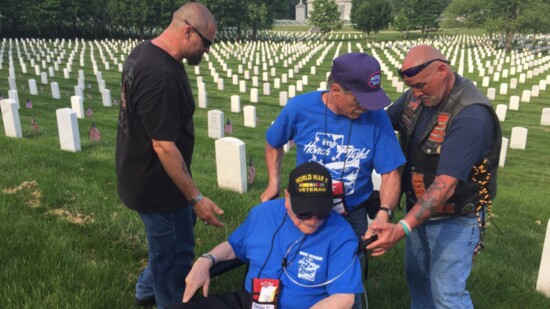As a volunteer for Utah Honor Flight, I had the privilege of joining nine unforgettable trips with men and women who made great sacrifices during World War II, the Korean War and Vietnam. These flights were more than just a journey to Washington, D.C.; they were a long-overdue tribute to brave military veterans who sacrificed so much. Each trip was filled with moments that were heartwarming, inspiring and often deeply emotional.
As Veterans Day approaches each year, snapshots of those awesome experiences flood my mind, but there is one miracle—yes, a miracle—that stands out above all.
And it all started with a simple question: "Could I see my brother?"
First, some background. The idea behind Honor Flight was born in 2005, shortly after the National World War II Memorial was completed. The mission was clear: get as many WWII veterans to the memorial as possible, before time ran out.
In 2013, UHF joined the national network, and soon after, I had the opportunity to be part of this incredible experience. My first flight was in June 2014, when I was a reporter for the local newspaper. I was there to cover the story—but I left with something much deeper. I was hooked.
In 2016, I left the newspaper but continued to be involved with UHF, joining its Board of Directors and becoming a flight leader. That year, during Memorial Day weekend, I helped lead one of the largest groups we’d ever taken to D.C. Our itinerary was packed: we visited the WWII, Korean War, Vietnam War, and Lincoln Memorials on the National Mall, paid our respects at the Franklin D. Roosevelt Memorial, marveled at the towering Air Force Memorial, and ended with a solemn stop at Arlington National Cemetery.
Most trips go off without a hitch. Not this time. Due to a booking mix-up, we ended up with buses that were too small for our group. Normally, two large buses would have been enough. However, these buses were too small, so we needed three. Just as consequential, these buses didn’t have storage underneath. Big problem.
We were transporting approximately 58 WWII veterans. Most were in their late 80s or 90s, so we made wheelchairs available for each of them. We needed somewhere to put them on the ride into town, so we rented a large van.
We also had to have an additional vehicle to help maintain communication for this group, so that made us a five-vehicle convoy. This unexpected hurdle was initially frustrating. But it gave us an incredible opportunity.
During the trip, Carlos Cerna, a Navy veteran, asked the UHF chairman if it might be possible to visit a grave at Arlington—that of his brother, John, killed in action during the Korean War. Ordinarily, this was not possible. The trip moves fast. Sending a bus on a wild goose chase to get one veteran close to a grave site? It’s a pipe dream.
If you have never been to Arlington National Cemetery, I highly recommend it. It’s not the place, however, to go hunting for an individual grave. There are approximately 400,000 veterans buried at Arlington.
However, with the extra car and an active-duty serviceman with knowledge of the cemetery joining our team, we were able to locate the grave’s whereabouts. Great news! The not-so-great news was that it was located in the middle of a large grass field. Carlos was on oxygen and could only walk a few steps at a time. Plus, the wheelchairs we had weren’t ideal for off-roading.
Then, like a scene straight out of a movie, two burly bikers appeared. They were in town for Rolling Thunder, the Memorial Day ride honoring veterans and raising awareness for POWs and MIAs. These guys were like guardian angels—they lifted, pushed and pulled Carlos’ wheelchair through the grass, all the way to the site.
I tear up thinking about it.
What I didn’t know at the time was that Carlos had served aboard the USS Johnston during the Battle of Leyte Gulf. It was sunk by a Japanese cruiser on October 25, 1944, forcing him and his shipmates to leap from the Johnston into the shark-infested waters below. Carlos endured 52 hours in the Philippine Sea with meager rations, little water and predators looming.
He knew a thing or two about miracles.
David Cordero serves as communication and marketing director for the City of St. George overseeing all of the city's communication efforts, both internally and externally. He has lived with his family in St. George since 2006, and has served in a variety of volunteer capacities for several local non-profit organizations, and as a coach for his son's athletic teams.
